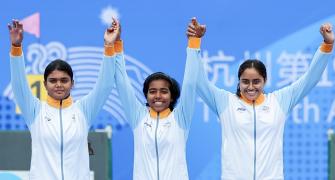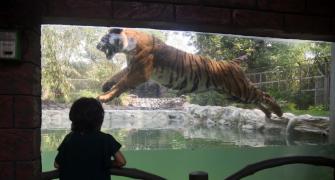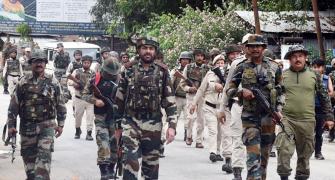Kaleidoscopic images of India's rich cultural diversity and its military might unfolded at the majestic Rajpath on Friday as the nation celebrated the 58th Republic Day amidst tight security.
An impressive and colourful parade, a traditional attraction of the national event, marched down the broad avenue connecting the magnificent Rashtrapati Bhawan and the India Gate as President A P J Abdul Kalam took the salute from marching contingents.
Armed forces in battle regalia, proudly marching before their supreme commander, fascinating tableaux depicting the diverse culture, country's prized armaments and hundreds of colourfully-dressed dancing schoolchildren formed part of the 105-minute-long parade.
The annual extravaganza was watched by Russian President Vladimir Putin, the chief guest, Vice President Bhairon Singh Shekhawat, Prime Minister Manmohan Singh, United Progressive Alliance Chairperson Sonia Gandhi and the entire military and political top brass besides a large enthusiastic crowd that had gathered on either sides of the sun-drenched Rajpath.
Ahead of the parade, the prime minister, Defence Minister A K Antony and the three Service chiefs laid wreaths at the Amar Jawan Jyoti at India Gate where an eternal flame burns in memory of those countless personnel in uniform who laid their lives defending frontiers of the nation.
President Kalam and his Russian counterpart Putin arrived at the Rajpath escorted by President's bodyguards riding impeccably-trained horses.
With unfurling of the tricolour by the President and the playing of national anthem by military bands followed by a customary 21-gun salute, the parade began as Air Force helicopters showered flower petals on the gathering.
Present among the audience were prime minister's wife Gursharan Kaur, Lok Sabha Speaker Somnath Chatterjee, Union ministers and Leader of the Opposition L K Advani.
The first to appear in the parade were winners of the Param Vir Chakra and Ashok Chakra, the nation's highest gallantry awards, followed by mounted columns of the 61st Cavalry led by Malaysian Prince Captain Tunku Ismail Ibrahim, the first foreigner to take part in the parade.
The Army showcased its T-72 tanks, Bofors guns, Pinaka multi-barrel rocket launching system, tactical control reporter radar, mobile de-contamination system and Army Wide Area Network on mobile node. The indigenously-built Advanced Light Helicopter 'Dhruv' was also showcased with three of the choppers flying past Rajpath.
Colourfully-attired military contingents made their entry marching to the tune of motivational song 'kadam kadam badaye jaa.'
The Parachute Regiment was followed by Brigade of the Guards, the first mechanised battalion of the Army, and various other regiments accompanied by their bands. Tableau of the Remount Veterinary Corps displaying the Army sniffer dog contingent, and a float on military world games to be hosted by India later this year with its mascot 'Bravo', the great India bison, stood out for their uniqueness.
Smartly-dressed Navy personnel came along with a tableau depicting new Naval acquisitions like INS Talwar, IL-38 aircraft and Scorpene submarine linked through a network, while the Air warriors, accompanied by indigenously developed Indra-II radar, marched to lilting tunes of the 'Tiger Hill.'
The country's military prowess was unveiled by the DRDO, which showcased Brahmos supersonic cruise missile, unique small-sized 'Ex Tank,' Nag anti-tank guided missile, Akash weapon system, weapon-locating radars and a host of border surveillance equipment.
Putin was seen taking keen interest in the armament showcased in the parade as President Kalam offered him insight into equipment on display.
The BSF's colourful camel contingent and the camel band, one of its kind in the world, drew loud cheers. Clad in snow-combat dress, the 'himaveers' of the Indo-Tibetan Border Police also attracted attention.
The cultural pageant, comprising tableaux of 18 states and eight ministries, depicted themes varying from natural beauty to traditional crafts and festivals.
Goa made a grand entry giving a glimpse of its famed architecture, communal harmony and rural lifestyle. Arunachal Pradesh presented its varied flora and fauna and its unique cane-suspension bridges used to traverse inhospitable terrain. Chhattisgarh exhibited the traditional bell metal artefact-making 'Dokra Art' while Uttarakhand projected its tourism attraction with a depiction of the famed Corbett National Park, the tiger reserve on the foothills of the Himalayas.
Himachal Pradesh displayed Dhankar and Kee Buddhist monasteries, reflecting its religious diversity while southern state Kerala presented its institute of music and art -- Kalamandalam that imparts knowledge of art forms, including 'Kathakali,' 'Koodiyattam' and 'Panchavadyam' in 'Gurukul' tradition.
The 'Sarhul' festival -- where tribes worship the Sal tree for its therapeutic value -- was the highlight of the state tableau of Jharkhand, while blend of all faiths in Jammu and Kashmir came alive on its tableau carrying models of the Bavey Wali Mata temple, the Charar-e-Sharif mosque and the Hemis Monastery in Ladakh region.
The thriving beekeeping industry producing high quality natural honey and juicy oranges that make Meghalaya famous was the theme of its float while the Kangla festival, when Manipuris from hills and plains gather dressed in traditional attire to pray for peace and prosperity, was the focus of the state tableau.
Assam depicted the evolution of the oil industry in India while Madhya Pradesh projected the diversity of its art culture through the annual Tansen Festival of Gwalior held in memory of the legendary musician.
The Maharashtra tableau brought out the unison of Shaiva and Vaishanav forms of worship, while famed wooden toys, masks and paper works adorned the tableau of Orissa.
Uttar Pradesh dedicated its tableau to the memory of the first war for Independence, while Mizoram presented its efforts in soil and water conservation and Delhi brought out the contribution made by women in various fields.
The Ministry of Culture remembered the Satyagraha movement of Mahatma Gandhi that was launched 100 years ago while Social Justice and Empowerment Ministry depicted the ill-effects of drugs. Also on display were the tableaux of Ministries of Railways, Road Transport and Central Industrial Security Force.
The little heroes who won the national bravery awards came riding on elephants and earned a big round of applause. Song and dance performances by around 1200 schoolchildren from across the country were also lapped up by the audience.
The dare devil motorcycle team of the Corp of Military Police performed some breathtaking stunts. The grand finale came in the form of the zooming frontline flying machines of the Indian Air Force. The Mi-26 and Mi-17 helicopters were followed by an IL-76, two AN-32 transport aircraft and two Dornier planes.
The IL-78 aircraft performed the complex mid-air refuelling of two Sukhoi multi-role fighters at a speed of 510 km per hour as the Jaguars and MiG-29 flew in arrowhead formations. The spectacular air-show climaxed with three Su-30 aircraft making the stunning 'trishul' formation.





